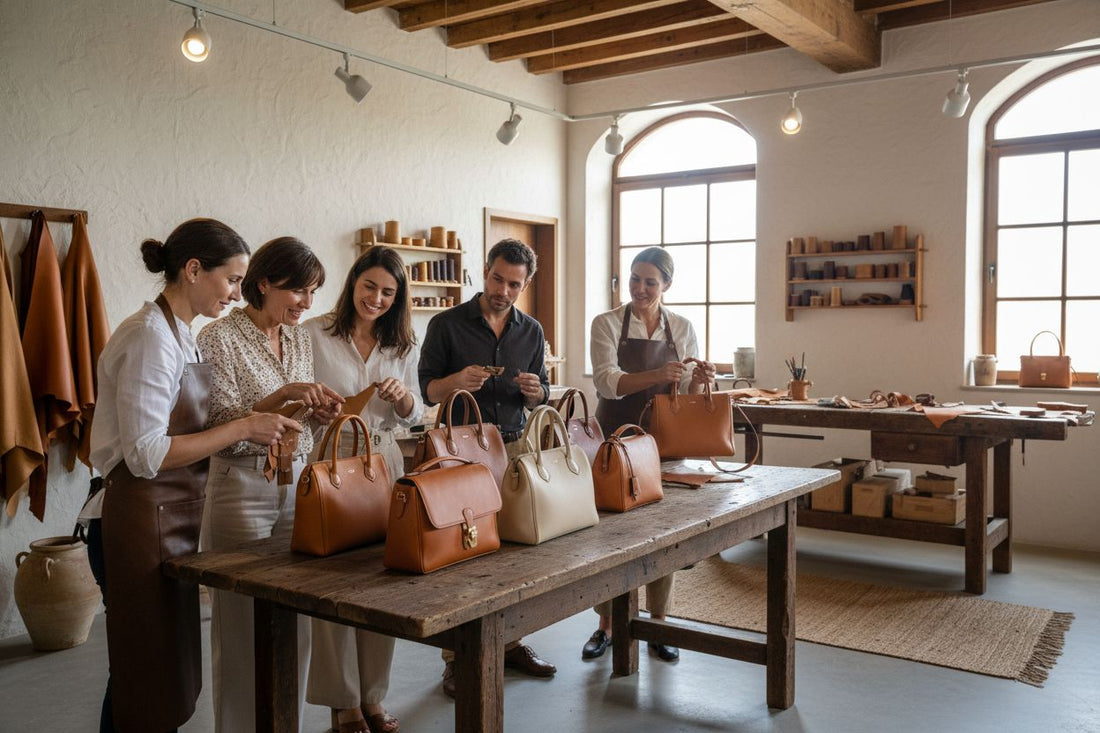
8 Best Italian Leather Handbags Made in Italy to Explore
Share
Italian leather handbags are more than just stylish accessories. They represent centuries of artistry and tradition, with crafting methods recognised by UNESCO as intangible cultural heritage. Most people see a beautiful bag and think it is all about the look. The real secret lies in the details and the heritage that make each Italian handbag a genuine masterpiece.
Table of Contents
- Understand The History Of Italian Leather
- Identify The Best Italian Brands For Leather Handbags
- Recognise Key Features Of Quality Italian Leather
- Explore Iconic Italian Handbag Styles
- Learn How To Spot Authentic Italian Handbags
- Find Sustainable Options Among Italian Leather Handbags
- Discover Care Tips For Your Italian Leather Handbag
- Consider The Best Places To Buy Authentic Italian Bags
Quick Summary
| Takeaway | Explanation |
|---|---|
| Italian leather has a rich history | It originates from Tuscany, where exceptional craftsmanship has developed over centuries. Traditional techniques are still used today. |
| Look for key quality indicators | True Italian leather displays natural grain, durability, and minimal chemical processing, ensuring lasting quality. |
| Authenticate Italian handbags carefully | Examine stitching, leather texture, and hardware to spot genuine Italian craftsmanship and avoid imitations. |
| Sustainability is essential | Prioritise brands using eco-friendly tanning techniques and ethical practices, reflecting a commitment to the environment. |
| Proper care extends handbag lifespan | Store in breathable bags, avoid direct sunlight, and regularly condition leather to maintain its beauty and durability. |
1: Understand the History of Italian Leather
The story of Italian leather is a remarkable journey spanning centuries, deeply rooted in tradition and unparalleled craftsmanship. Originating in the medieval regions of Tuscany, particularly Florence and Venice, leather production became an art form that transformed Italy into a global leader of luxury leather goods.
According to UNESCO World Heritage Research, Italian leather crafting represents an intangible cultural heritage with techniques passed down through generations. The process begins with careful animal hide selection, where master artisans choose only the highest quality raw materials.
Key historical milestones in Italian leather development include:
- The emergence of leather guilds in medieval Florence during the 13th century
- Technological innovations during the Renaissance that refined tanning techniques
- Establishment of sophisticated leather workshops in regions like Tuscany and Lombardy
By the 20th century, Italian leather became synonymous with luxury and exceptional quality. Regions such as Tuscany developed specialised techniques that transformed simple animal hides into exquisite, durable materials. Learn more about our guide on Italian leather craftsmanship to appreciate the intricate processes behind each handcrafted piece.
Today, Italian leather represents more than just a material—it embodies a rich cultural narrative of skill, passion, and unwavering commitment to excellence. The meticulous attention to detail, from hide selection to final treatment, continues to set Italian leather apart in the global marketplace.
2: Identify the Best Italian Brands for Leather Handbags
Navigating the world of Italian leather handbag brands requires understanding the nuanced landscape of craftsmanship, design, and heritage. Not all brands are created equal, and discerning luxury consumers seek those with deep-rooted traditions and exceptional quality.
According to Luxury Fashion Research Institute, several key characteristics define top Italian leather handbag brands:
- Commitment to traditional artisanal techniques
- Use of premium full-grain leather
- Generational expertise in leather manufacturing
- Innovative yet timeless design approaches
While numerous brands claim excellence, authentic Italian leather handbag brands distinguish themselves through meticulous attention to detail and generational knowledge. Explore our comprehensive guide on understanding Italian handbag craftsmanship to appreciate the intricate processes behind each masterpiece.
Regional specialisation plays a crucial role in brand reputation. Tuscan manufacturers, for instance, are renowned for their exceptional leather treatment techniques, while Venetian artisans excel in sophisticated design elements. Contemporary Italian brands blend historical techniques with modern aesthetics, creating handbags that are both functional and artistic statements.
The most respected Italian leather handbag brands demonstrate an unwavering commitment to quality, sustainability, and cultural heritage. They view each handbag not merely as an accessory but as a narrative of Italian craftsmanship, representing generations of skill, passion, and uncompromising standards.
3: Recognise Key Features of Quality Italian Leather
Quality Italian leather represents a pinnacle of craftsmanship that goes far beyond surface appearance. Discerning consumers understand that true excellence lies in multiple nuanced characteristics that distinguish exceptional leather from ordinary materials.
According to International Leather Industry Research, several fundamental features define premium Italian leather:
- Natural grain and texture preservation
- Minimal chemical processing
- Exceptional durability and resilience
- Ability to develop a rich patina over time
Full-grain leather stands as the highest quality classification, representing leather where the entire natural grain remains intact. This means the hide retains its original surface, showcasing natural markings and inherent strength. Discover more about the value of Italian leather craftsmanship to understand its remarkable characteristics.
The tanning process plays a critical role in leather quality. Traditional Italian tanneries employ vegetable tanning techniques that have been refined over generations, using natural tannins extracted from tree bark. This method produces leather with superior strength, remarkable colour depth, and environmental sustainability.
Key indicators of exceptional Italian leather include its smooth yet substantive texture, ability to age gracefully, and resistance to wear. Professional leather experts evaluate materials based on touch, flexibility, colour consistency, and natural imperfections that tell a unique story of origin and craftsmanship.
4: Explore Iconic Italian Handbag Styles
Italian handbag styles represent a sophisticated fusion of artistic heritage and contemporary design, each telling a unique narrative of craftsmanship and elegance. The diversity of styles reflects Italy’s rich design history and regional influences.
According to European Fashion Design Institute, iconic Italian handbag styles are characterised by:
- Impeccable structural integrity
- Minimalist yet sophisticated design
- Versatility across professional and social contexts
- Emphasis on functional elegance
Tote bags emerge as quintessential Italian design, offering spacious interiors with refined silhouettes perfect for professional women. Structured shoulder bags showcase architectural precision, while soft-sided leather bags demonstrate remarkable flexibility and understated luxury.
Learn more about the unique benefits of Italian handbag design, exploring how each style represents generations of design expertise.
Regional design influences play a significant role. Tuscan designs often feature clean lines and neutral colour palettes, while Venetian styles incorporate more intricate detailing and experimental shapes. Contemporary Italian handbag styles balance traditional craftsmanship with modern aesthetic sensibilities, creating pieces that are both timeless and innovative.
The true hallmark of Italian handbag styles lies not just in appearance, but in the meticulous attention to detail – from perfectly aligned stitching to strategically placed internal compartments that demonstrate profound understanding of functional design.
5: Learn How to Spot Authentic Italian Handbags
Authenticating Italian handbags requires a discerning eye and understanding of sophisticated craftsmanship markers that distinguish genuine luxury from imitations. Consumers must develop keen observation skills to ensure their investment represents true Italian artisanal excellence.
According to International Luxury Authentication Institute, critical authentication markers include:
- Precision of stitching and thread quality
- Consistent leather grain and natural imperfections
- High-quality hardware with refined finishing
- Expertly constructed interior lining
Leather quality remains the most significant indicator of authenticity. Genuine Italian leather exhibits a soft, supple texture with natural variations that machine-produced replicas cannot replicate. Explore our comprehensive guide on understanding Italian leather quality to develop your expertise.
Careful examination of manufacturing details provides crucial insights. Authentic Italian handbags demonstrate impeccable attention to detail, with seamless construction, balanced proportions, and hardware that feels substantial and precisely integrated. The internal label should feature clean, crisp typography and include specific manufacturing information.
Additional authentication techniques involve assessing leather smell, examining hidden seams, and understanding regional manufacturing signatures. Tuscan leather, for instance, carries a distinctive rich aroma and exhibits subtle natural grain variations that represent generations of expert craftsmanship.
ultimately, purchasing from reputable sources and understanding the nuanced characteristics of Italian leather craftsmanship remains the most reliable method of ensuring authenticity.
6: Find Sustainable Options Among Italian Leather Handbags
Sustainable Italian leather handbags represent a growing movement within the luxury fashion industry, combining traditional craftsmanship with environmentally conscious production methods. Discerning consumers increasingly demand transparency and ecological responsibility in their luxury purchases.
According to Global Sustainable Fashion Research Centre, sustainable leather production focuses on several critical aspects:
- Minimising chemical usage in tanning processes
- Utilising recycled and upcycled leather materials
- Supporting ethical animal welfare practices
- Reducing overall environmental carbon footprint
Vegetable tanning techniques emerge as a primary sustainable approach, using natural tannins extracted from tree bark instead of harmful chromium-based chemicals. Explore the future trends of sustainable Italian leather production to understand the evolving landscape of ethical manufacturing.
Italian tanneries are pioneering innovative approaches like bio-based leather alternatives, developing materials from apple waste, grape skins, and other agricultural by-products. Circular economy principles are being integrated into leather production, transforming waste streams into valuable, high-quality handbag materials.
Ethical consumers should look for certifications such as the Leather Working Group (LWG) certification, which validates environmentally responsible leather manufacturing processes. These certifications ensure reduced water consumption, minimised chemical usage, and compliance with stringent environmental standards.
7: Discover Care Tips for Your Italian Leather Handbag
Preserving the beauty of Italian leather handbags requires meticulous care and understanding of specialised maintenance techniques. These luxurious accessories demand thoughtful attention to maintain their exceptional quality and aesthetic appeal.
According to Leather Conservation Institute, essential leather maintenance principles include:
- Avoiding direct sunlight exposure
- Storing in breathable dust bags
- Using specialised leather conditioning products
- Cleaning with soft, dry microfibre cloths
Leather conditioning plays a crucial role in maintaining the handbag’s suppleness and preventing premature aging. Learn comprehensive strategies for leather handbag storage and care to protect your investment.
Temperature and humidity significantly impact leather quality. Ideal storage conditions involve maintaining consistent room temperature, avoiding extreme fluctuations that could compromise leather’s natural structure. Professional leather experts recommend storing handbags in cool, dry environments with moderate humidity levels between 50-55%.
Additional protective measures include rotating handbag usage, maintaining internal structure with soft stuffing when not in use, and addressing minor scuffs or marks immediately with appropriate leather restoration techniques. Regular, gentle maintenance ensures your Italian leather handbag remains a timeless, elegant accessory that develops a beautiful patina over time.
Below is a comprehensive table summarising the key points and takeaways from the article, offering a concise overview of Italian leather handbags and essential knowledge for discerning buyers.
| Topic | Key Insights | Benefits/Actions |
|---|---|---|
| Heritage & Craftsmanship | Centuries-old traditions rooted in Tuscany and Venice; UNESCO-recognised techniques passed down through generations | Assurance of authenticity, pride in cultural heritage |
| Leading Italian Brands | Renowned for artisanal skill, generational expertise, and innovation blended with tradition | Trustworthy purchases; timeless and unique designs |
| Quality Features of Italian Leather | Full-grain, natural texture, minimal chemical processing, vegetable tanning | Exceptional durability; beautiful patina; ethical and sustainable material |
| Iconic Handbag Styles | Includes tote bags, structured shoulder bags, soft-sided designs; regional variations influence style elements | Versatility, elegance, and enduring appeal |
| Authenticity & Identification | Look for precise stitching, natural imperfections, quality hardware, and labels with manufacturing details | Avoidance of counterfeits; ensures genuine Italian workmanship |
| Sustainability | Emphasis on vegetable tanning, recycled materials, and circular economy; LWG certification indicates responsible practices | Responsible luxury with reduced environmental impact |
| Care & Maintenance | Store away from sunlight, condition regularly, use breathable dust bags, maintain stable humidity and temperature | Prolonged handbag life; maintains suppleness and aesthetic appeal |
| Where to Buy | Specialised boutiques, direct manufacturers, and reputable online retailers; ensure documentation and provenance | Secure, authentic purchases; direct engagement with artisans and quality guarantee |
8: Consider the Best Places to Buy Authentic Italian Bags
Purchasing authentic Italian leather handbags requires strategic selection of reputable sources that guarantee genuine craftsmanship and quality. Discerning buyers must navigate multiple purchasing channels with careful consideration.
According to Global Luxury Retail Research, key considerations for purchasing authentic Italian bags include:
- Verifying direct manufacturer credentials
- Examining comprehensive product documentation
- Understanding return and authenticity guarantee policies
- Researching brand provenance and manufacturing heritage
Specialised boutiques and direct manufacturer outlets emerge as the most reliable purchasing channels. Understand the nuances of selecting premium Italian handbags to make an informed decision.
Online platforms present both opportunities and challenges. Reputable websites specialising in Italian leather goods often provide detailed product descriptions, high-resolution imagery, and certificates of authenticity. Professional buyers recommend requesting additional documentation, such as manufacturing origin certificates and detailed leather composition reports.
Regional shopping destinations like Florence, Milan, and Venice remain unparalleled for those seeking direct access to exceptional Italian leather handbags. These cities host flagship stores and artisan workshops where consumers can witness craftsmanship firsthand and engage directly with skilled leather artisans.
Experience True Italian Leather Luxury with San Rocco Italia
Finding the perfect Italian leather handbag can feel overwhelming, especially when you want assurance of authenticity, sustainability, and artful design. The article highlights concerns such as how to recognise genuine materials, trust reputable brands, and invest in handcrafted excellence. At San Rocco Italia, we understand the challenge of navigating so many options while aiming for timeless style and exceptional quality.

Why settle for uncertainty when you can discover handbags carefully crafted in Italy by skilled artisans using only premium full-grain leather? Every piece at San Rocco Italia is made with meticulous attention to detail, reflecting the very heritage discussed in our guide to understanding Italian leather craftsmanship. If you want to see how tradition meets modern elegance, explore our expert insights on the benefits of Italian handbags. Visit San Rocco Italia now to find your authentic Italian masterpiece and let your next handbag tell a genuine story of quality and heritage.
Frequently Asked Questions
What are the characteristics of quality Italian leather handbags?
Quality Italian leather handbags are characterised by natural grain preservation, exceptional durability, and minimal chemical processing. They exhibit a soft texture, develop a rich patina over time, and often come in full-grain leather, which retains its original surface features.
How can I spot an authentic Italian leather handbag?
To spot an authentic Italian leather handbag, look for precise stitching, high-quality hardware, and natural imperfections in the leather that signify artisanal craftsmanship. Check for a clear internal label that includes manufacturing information as well.
What care tips should I follow for my Italian leather handbag?
To care for your Italian leather handbag, store it in a breathable dust bag away from direct sunlight, regularly condition the leather to keep it supple, and clean it with a soft, dry microfibre cloth to remove dust and minor marks.
What are the benefits of vegetable-tanned leather in handbags?
Vegetable-tanned leather is environmentally friendly, as it uses natural tannins instead of harmful chemicals. This method produces leather with enhanced strength and colour depth while maintaining ethical animal welfare practices.


